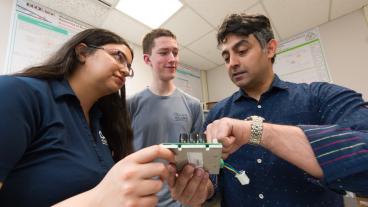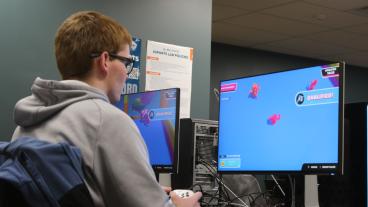Mines researchers contribute to development of more efficient frequency combs

Optical frequency combs (OFCs)– devices that act as ultra-precise rulers for measuring light – have powered multiple applications since their introduction in 2000, from cutting-edge timekeeping and astronomy to data communication and remote sensing.
But the devices’ power-hungry nature and resulting large size has limited their efficiency and applicability in more compact environments – until now.
Researchers from Colorado School of Mines are part of an international team of scientists that have unlocked a major advance in the design of electro-optic OFCs, reducing the power requirement of the combs by 16 times while fitting everything on a tiny millimeter-sized chip.
The development on the new lithium tantalate platform was a collaboration between photonics, microwave and materials engineering researchers at Mines, Ecole Polytechnique Federale de Lausanne (EPFL) in Switzerland and the Chinese Academy of Sciences . The team’s findings were recently published in the journal Nature.

“The new device created by the team is not just smaller and more efficient, but also much easier to use,” said Connor Denney, a graduate student in electrical engineering at Mines and co-author on the paper. “Additionally, these new devices are compatible with scalable volume manufacturing in commercial foundries.”
The potential application of the smaller, low-power OFCs are wide ranging, from faster, greener internet connections to more accurate self-driving car sensors, ultra-precise clocks and astro-spectral calibration, said Gabriel Santamaria-Botello, assistant professor of electrical engineering and fellow co-author on the paper.
The new combs also work right out of the box, eliminating the need for fiddly tuning processes and opening the door to wider use across industries, he said.
“The new device generates a very broad spectrum of light—spanning more than 450 nanometers— while being 16 times more power efficient than previous designs,” Santamaria-Botello said. “This makes it a powerhouse in a package no bigger than a thumbnail, making it much easier to use and deploy in real-world applications. It also illustrates the great performance boosts that are possible with integrated photonics and microwave co-design.”
To read the full Nature paper, “Ultrabroadband integrated electro-optic frequency comb in lithium tantalate,” go to https://www.nature.com/articles/s41586-024-08354-4.




